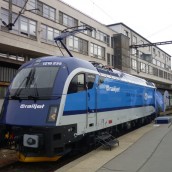The first ČD railjet unit officially launched test operations with passengers on 6 May. The ČD railjet train commenced its maiden voyage on regular connection IC 571 Zdeněk Fibich from Prague Main Station (Praha hl.n.) to Břeclav. In the coming days, passengers will encounter a ČD railjet unit on IC 572 / 573 Brněnský drak Brno hl.n. (dep. 6:39) – Praha hl.n. (arr. 9:21 / dep. 16:39) – Brno hl.n. (arr. 19:19). From mid-June, ČD is planning international test operations of a ČD railjet unit on EC 72 / 73 Smetana and EC 74 / 75 Franz Schubert, and from December ČD railjet units and ÖBB railjet units will connect Prague, Brno, Vienna and Graz at regular two-hour intervals.
By introducing railjets, ČD is strengthening its position in the area of international long-distance transport, and the Czech national carrier thus becomes part of an international network of fast and comfortable trains to which it will connect directly at the newly constructed Vienna Main Station transfer hub. This cooperation will benefit mainly passengers, who can also use the most modern type of train in inland transport between Prague, Pardubice, Brno and Břeclav.
“Today, we have enabled our passengers to use the first completely new train for long-distance transport, which represents – in addition to many technical innovations – a new level of quality in travel. Air-conditioning, an information system, restaurant, accessibility modifications for passengers using wheelchairs – these are already automatic components of many of our trains, but here we are offering our passengers additional new services and improvements as well,” says ČD’s Chairman and CEO, Daniel Kurucz, adding specific examples: “Business travellers can take advantage of the serenity of the new business class section with comfortable adjustable armchairs, while families with children will appreciate reserved seating near the children’s cinema. Nearby, there is also space for stowing prams and strollers. We’re also thinking about cyclists, which is not usual for similar fast trains. For these reasons, railjet between Prague and Brno is a good alternative not only to the bus but also to the personal automobile. The quality and speed of trains on this line is now at the European level, and railjet trains only confirm this fact.”
“Today’s launch of test operations of the railjet fast train moves the realisation of the contract between ČD and Siemens into the next phase. Railjets will bring to Czech customers modern railway travel at the European standard to which passengers in Western Europe are accustomed. The remaining six railjet units should appear gradually on the Czech railway network by the end of this year. A Czech team from the Siemens development centres in Prague and Ostrava participated in the structural design of the high-speed railjet trains,” says Roman Kokšal, director of the transport division at Siemens.
Modern ČD railjet units offer their passengers a high level of comfort as well as faster travel. Travel time between Prague and Vienna will be reduced from the current 4 hours 45 minutes to approximately 4 hours 10 minutes. After modernisations are completed on several line segments in the Czech Republic, ČD plans to reduce travel time between Prague and Brno as well. It will then be possible to travel from Prague to Vienna in less than 4 hours.
ČD railjet units offer their passengers the following services and benefits:
- a comfortable business section with adjustable armchairs;
- a 1st class section with leather adjustable seats and folding or retractable table trays;
- 2nd class seats arranged behind one another or opposite one another with folding or retractable table trays;
- 230 V electrical outlets in all carriages for charging passengers’ small electronic devices, e.g. laptops, mobile telephones, tablets and other devices;
- an on-board restaurant with a rich offering of foods and beverages;
- in 1st class and business class, in-seat food and beverage service from the restaurant carriage; in 2nd class, an offering of refreshments from the minibar;
- spaces for passengers using wheelchairs, including modified accessible WCs;
- a children’s cinema with reserved seating for passengers travelling with children, including space for stowing prams and strollers;
- space for transporting 6 bicycles;
- generously dimensioned storage spaces for luggage;
- a modern audio-visual information system with LCD displays and an electronic reservation system;
- air-conditioning;
- a pressure-tight carriage body which reduces unpleasant sudden charges of pressure when entering tunnels or when two trains pass each other;
- wide, accessible passages between carriages without doors.
ČD’s 7-carriage railjet has a total of 442 seats, of which 6 are in business class and 42 are in 1st class. The train can travel at up to 230 km/h, is 185 m long without the locomotive and weighs 350 tonnes. Today, railjet trains are deployed on international connections between Hungary, Austria, Switzerland and Germany. And from December 2014 the Czech Republic will be added to this list as well.
This year, ČD is celebrating 175 years of railway transport. The first line on Czech territory, running from Vienna to Břeclav, was opened on 6 June 1839, and train operations from Vienna all the way to Brno were christened on 7 July 1839. ČD’s completely new railjet units are heading for this country’s oldest line in the jubilee year 2014. České dráhy, a.s., (ČD) is the continuator and direct successor of the former railway companies.
Press Release of Ceske drahy, 5 May 2014
